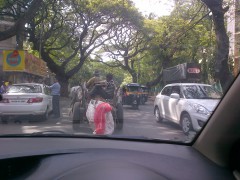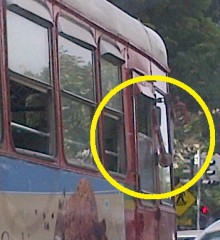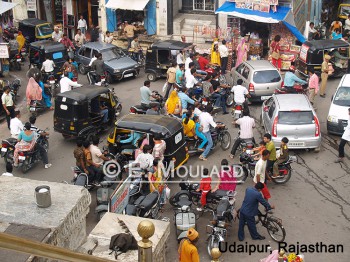10/20/2013
Why in India it's the jungle on the roads?
 I drove my four colleagues to the restaurant the other day. One of them appreciated my driving style by passing the following comment: “If a cop stopped you he would immediately give you the Indian nationality!” Understand that, in ten minutes, I had honked enough and went through enough red lights to be called an Indian!
I drove my four colleagues to the restaurant the other day. One of them appreciated my driving style by passing the following comment: “If a cop stopped you he would immediately give you the Indian nationality!” Understand that, in ten minutes, I had honked enough and went through enough red lights to be called an Indian!
But then, why do Indians drive so bad?
I stop you immediately, it is not because of women! In 2011, only 11% of the driving licenses belonged to women (1); and most of them don’t even drive...
It's a combination of factors that explains the anarchy that reigns on the roads in India...
There are not enough roads (even if the road network is the second worldwide in terms of kilometres and increases from 4% per year since 1951) (2); and especially they are horrible! And I am not talking about the roads of Madhya Pradesh (where it takes 10 hours to cover 500 kms); Mumbai (the economic capital) asphalt has more holes than the gruyère!
The number of drivers increases super-fast, a few dozen millions every year.
And the practice of driving is relatively new: in one generation (20 years) the number of vehicles on the roads has gone up from 5 to 142 million! And yet... barely 1% of Indians own a car. (3) Scary! (except perhaps for the automakers...)
 Most people use public transport (90% of it being the bus) or auto-rickshaws. But bus drivers are the mentally challenged: they do not stop under any circumstance (not even to load passengers). Mumbai bus drivers even operate manually their turning signal – a steel arrow placed on the front windows. When they operate it. Most the vehicles date back to Methuselah and they often carry 2 to 3 times the number of scheduled passengers. Hence tens of thousands of victims of the public transport in India every year... (4)
Most people use public transport (90% of it being the bus) or auto-rickshaws. But bus drivers are the mentally challenged: they do not stop under any circumstance (not even to load passengers). Mumbai bus drivers even operate manually their turning signal – a steel arrow placed on the front windows. When they operate it. Most the vehicles date back to Methuselah and they often carry 2 to 3 times the number of scheduled passengers. Hence tens of thousands of victims of the public transport in India every year... (4)
To top it off, most Indians got their license in a lucky bag or somethin! Technically, when you apply, they give you a temporary license and to get the final license you have to pass a driving test (driving lessons are not compulsory however). I did a round table and three of my four colleagues have not given the exam... You can buy everything in India! As a result, most Indians seem to ignore the difference between high and low beam headlights and you can get totally blinded when you drive at night in a city (especially in Delhi)...
I found an online test to check if you know the driving ; thereregulations are only a dozen simple questions (5). I did it, and then I went on to search for the driving rules in India (6). There are just 30: keep left; drive on the left side when planning to turn left; drive on the right side when planning to turn right; pass to the right (unless the vehicle before you has stopped to turn right); slow down when arriving at an intersection or a crosswalk, when entering a road interjection, if the road entered is a main road designated as such, give way to the vehicles proceeding along the road, and in any other case give way to all traffic approaching to the intersection on his right hand; do not u-turn when it is prohibited; stop for pedestrians; give free passage to ambulances; do no drive a vehicle in a reverse direction into a road designated ‘One Way’; stop at the signal and the police officer who controls traffic. And that’s pretty much it!
simple questions (5). I did it, and then I went on to search for the driving rules in India (6). There are just 30: keep left; drive on the left side when planning to turn left; drive on the right side when planning to turn right; pass to the right (unless the vehicle before you has stopped to turn right); slow down when arriving at an intersection or a crosswalk, when entering a road interjection, if the road entered is a main road designated as such, give way to the vehicles proceeding along the road, and in any other case give way to all traffic approaching to the intersection on his right hand; do not u-turn when it is prohibited; stop for pedestrians; give free passage to ambulances; do no drive a vehicle in a reverse direction into a road designated ‘One Way’; stop at the signal and the police officer who controls traffic. And that’s pretty much it!
Except on it comes to signals! Judge by yourself: "When about to slow down, extend the right arm with the palm downward; when about to stop, raise the right forearm vertically outside, palm to the right; when about to turn to the right, extend the right hand in a horizontal position outside with the palm of the hand turned to the front; when about to turn to the left, extend the right arm and rotate it in an anticlockwise direction; when about to overtake, extend the right hand and arm horizontally outside and bring the arm backward and forward in a semi- circular motion. The signals referred above may be simplified also by mechanical or electrical devices."
To conclude, the most important rule (which is not written) is: look straight and drive! The others will manage to avoid you, no problem...
Let us not forget the hyper-individualistic behaviour of Indians in certain circumstances (apparently inherited from the time of protectionism, rationing and shortages, where the Indians had to fight, literally, to have access to any consumption good (food, radio, clothes etc.). Behaviour you can come across when waiting in a line or… driving!
And above all I would like to highlight that cars are not the only ones who have the right to use the roads... Cows, goats, bullock-carts, tractors, horses also have a right of way.
Mix all that and you get chaos on the roads! And obviously there are a lot of accidents and many more lethal ones that one might imagine given the slow speed of driving... (7)
(1) Source: http://articles.timesofindia.indiatimes.com/2012-03-08/chennai/31135711_1_women-friendly-licences-motorcycle-manufacturers
(2) If the India has the second road network in the world with 4.2 million kilometers which grows 4% annually since 1951 (3.4% since 2001), it's still a growth over half the number of cars. Source: http://www.indiaspend.com/investigations/indias-traffic-n...
(3) 0.3 million vehicles in 1951, 5.4 million in 1981, 21.4 million in 1991, 55 million in 2001 and 142 million in 2011!
Sources: http://nctr.USF.edu/JPT/PDF/JPT%208-1%20Singh.PDF http://data.gov.in/dataset/state-wise-total-registered-mo...
Review of Urban Transportation in India: http://nctr.USF.edu/JPT/PDF/JPT%208-1%20Singh.PDF
The Indian fleet is almost five times that of France (with 142 million vehicles on Indian roads in 2011 against 31 million in France). Obviously if reported number of inhabitants the France has 4 times more vehicles per 1,000 inhabitants (481 against 118).
Sources: http://www.statistiques-mondiales.com/ue_voitures.htm; http://www.knowindia.NET/auto.html ; http://www.linternaute.com/auto/magazine/l-automobile-en-10-CHIFFRES-CLES/31-millions.shtml
(4) The bus represents 90% of public transportation in India – a trend shared all across the country except in Mumbai where trains carry 58% of the people who use public transport. In Delhi and Chennai less than half the people use public transportation. A trend opposed to Mumbai or Kolkata – which is due to the configuration of the cities (the first ones are less densely populated, more polycentric and geographically spread). The Delhi metro is superb but already crowded (especially at peak hours) and not practical: its star structure requires to always go back to the heart of the city to change lines. Bangalore and Kolkata also have the metro and it is under process in many other cities.
Sources: http://cistup.IISc.ernet.in/urban%20Mobility%208th%20March%202012/crisis%20Of%20public%20transport%20in%20India.PDF ; http://economictimes.Indiatimes.com/slideshows/infrastructure/ten-metro-rail-projects-transforming-Indian-cities/Kochi-Metro/slideshow/21478253.CMS
(5) http://rtoindia.com/startTest.asp
(6) http://auto.indiamart.com/user-manual/road-regulation.html
(7) http://www.indiansamourai.com/archive/2009/08/18/-.html
08:00 Posted in Why in India... | Permalink | Comments (0) | Tags: india, traffic, driving, highway code, rules, car, bus, public transportation, driving left, permitted, metro, road network, accidents, road, street, cows, goats, rickshaws | ![]() Facebook | |
Facebook | |
06/18/2013
Driving in the monsoon rains
I know that given the weather in Europe this year, it would not be welcome of me to complain about the rains here (all the most since it is still 28 degrees outside!).
But see, this afternoon I opened my car and there was 2 centimers of water on the floor! And then half of the roads were blocked because of floods - and this, my GPS (this idiot!) doesn't detect it yet!! I also banged a car, like a big accident. It was a combination of factors like we say: a moron who didn't know how to drive, my foot that slipped in my Crocs (I had to take on me to wear again these ugly shoes, quite practical in the rains) and a moment of distraction where I couldn't remember which pedal was the break! I don't know how but not even a scratch...
Here is how it looks (with a music I find quite adapted ;) ):
08:00 Posted in Funny things about India in videos, My stories in India | Permalink | Comments (0) | Tags: india, mumbai, driving, car, rain, monsoon | ![]() Facebook | |
Facebook | |
11/24/2012
Tir(ing) stories
For those who follow, I have been driving since June.
I have become expert in overtaking these bloody cycle-rickshaws but I still get a shock when the car in front of me suddenly pulls out and I find myself face to face with a cow, or a zebu, quite numerous in my industrial area.
My car is my freedom. I love it. I love driving. But more than that, it was quite necessary in such a big and spread city as Delhi. Here you get space (compared to Mumbai) but the price for it is that there are not too many things at leg’s reach.
But my car has also brought its share of hassles. Firstly you need to wash it every day otherwise you don’t recognize it. For instance, I have not been washing the roof of it for some time and it looks like it is wearing a white wig. Classy… Obviously, no one washes their car themselves – for 8 euros (500 rupees), anyone can do it for you. But I haven’t taken the time to look for someone and beside I like this intimate moment with my car. Except that it usually happens that I am in a rush and well-dressed when I have to wash it…
Small other hassles are there, like when an asshole flattens your tires regularly… The first time it happened, I didn’t realize I had a flat tire. A colleague of mine had to tell me. Alright, I had realized that there was something wrong, could just not figure out what exactly. So what do you do with a punctured tire in India huh?? Since I am a girl and quite tired, I would have liked to sit and cry like if the world had collapsed.
But a colleague of mine and our watchman took care of it and changed the tire. Then I went to the petrol pump but they didn’t deal in tires. They told me about a place that seemed very far – no change I would ever find it. So I listened to my conscience and went to the petrol pump next door. And here he was, the tire walla!
I was a bit ashamed to see a twelve year old change my tire in the dark night but he did it very well! It’s okay if I am not good at everything… He could not find a puncture and put back the tire. All this for 30 rupees (less than half a euro).
The next morning, the other tire was flat. I just went back to the tire shop and he took care of it. I go back regularly since I haven’t found out who does this…
And the best part of the story is that I take things with philosophy. I think six years ago, I would have blown a fuse and made a big scandal in the neighborhood. Now I just go to the tire walla…
08:03 Posted in Expatriation (in India and in other countries), My stories in India | Permalink | Comments (0) | Tags: india, driving, car, tire, flat, tire walla | ![]() Facebook | |
Facebook | |















